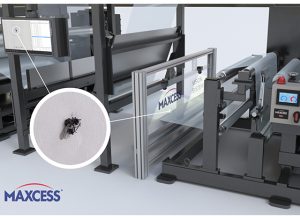The converting factory normally starts with a substrate. This can be paper , film, foil or sometimes a nonwoven. More often than not it’s plastic film. Our software is designed to inspect rolls or sheets of plastic. Usually a converter will pass the substrate through some other value added process, whether it’s printing, laminating, perforation or pouching. Sometimes it can be all of them.
Inspecting the extruded substrate

All plastic film include some level of contaminates, arising from the production process or due to the nature of polymers. Extrusion and converting lines classify many defect types such as gels, black specs, fish eyes, holes, oil stains, insects, scratches, coating voids, air bubbles and more. These all originate from different issues, but most all can have an impact on the further processing.
Vision systems should be able to locate all defects and identify the exact position, take a snapshot of the defect and alert the operator in real time. The end result is to avoid the production of waste. You can see benefits of deploying inspection in a number of areas including the film extrusion and converting process, the incoming raw material or at the final product especially during converting. By providing real time feedback on gel and black spec contamination, the machine downtime for any cleaning can be reduced and its capacity enhanced.
Gels or Fish-eyes are small film defects are normally characterized by their area and protrusion above the film surface. A gel count is one of the standard film properties. Foreign polymeric materials that do not completely melt form gels. Contaminants such as dust from bulk containers, particles and foreign materials, e.g. from poorly cleaned silos, can also cause fish-eyes. During the transfer of PE pellets through pipes, some of the PE pellets melt and smear on the walls and form ribbon-like streamers (angel hair) that flake off into the pellet stream. While the streamers are still adhering to the walls, their large surface area comes into prolonged contact with atmospheric oxygen. This can form fish-eyes. Deposits on the inside wall of the extruder and prolonged thermal exposure during a stoppage can also lead to fish-eyes with brown spots.
Maxcess vision solutions enable the control of film quality during production. We analyze material defects and provide real time feedback for the operator. It documents the quality of the product and supports the operator with the optimization of the production process. It guarantees total quality control and monitors key metrics in order to produce better, faster, and smarter converting.